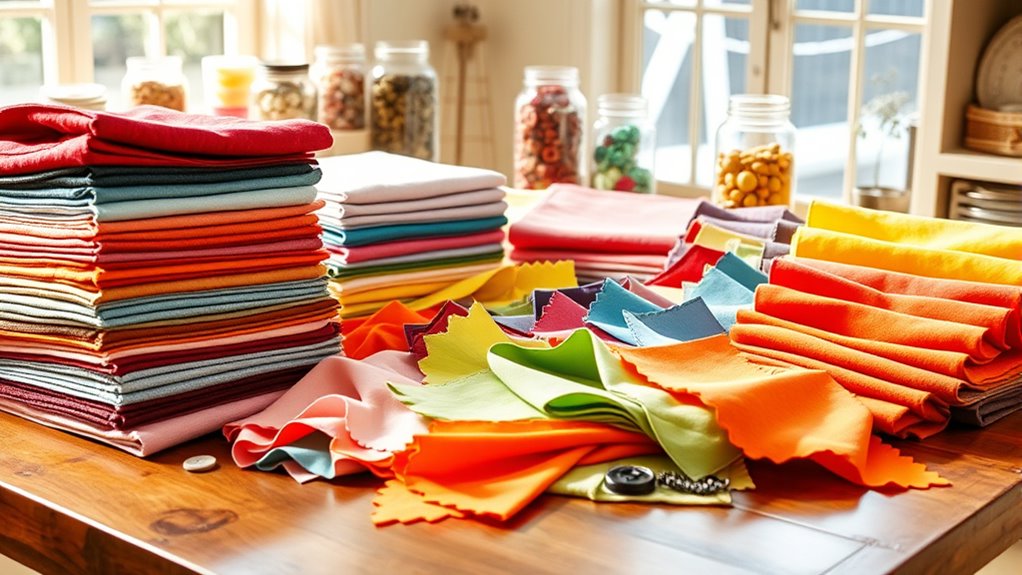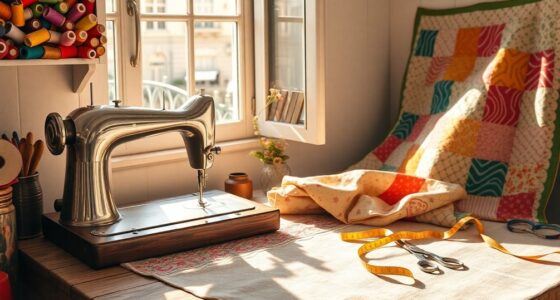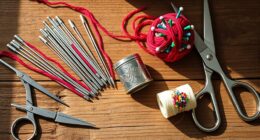To build a seasonal fabric library, focus on selecting versatile fabrics like denim, linen, and wool in weights suitable for different seasons. Stock up on both staple colors and textures, and consider care requirements to guarantee longevity. Sourcing from reliable suppliers helps prevent shortages, and organizing fabrics by season and care instructions makes projects smoother. Continue exploring to discover how to refine your collection for year-round use.
Key Takeaways
- Select versatile fabrics suitable for multiple seasons, like denim and twill, to maximize usability year-round.
- Include season-specific fabrics such as lightweight linens and cozy flannels to meet seasonal project needs.
- Prioritize high-quality, reliable suppliers to ensure consistent availability of desired fabrics.
- Organize fabrics by care instructions to maintain quality and simplify maintenance routines.
- Stock a variety of textures and colors to expand creative options and adapt to different project styles.

Creating a seasonal fabric library helps you stay prepared for any project by guaranteeing you have the right materials on hand throughout the year. When you curate a collection tailored to seasonal needs, you save time and reduce last-minute shopping trips. It also makes it easier to plan projects ahead, knowing you already possess suitable fabrics for upcoming seasons. But building this library isn’t just about grabbing fabrics randomly; it requires thoughtful consideration of fabric care and sourcing challenges. Different fabrics demand specific care routines, so understanding how each type responds to washing, ironing, and storage helps you maintain their quality over time. For example, delicate silks and wool blends need gentle handling, while cotton and linen are more forgiving. By organizing your fabrics according to their care instructions, you guarantee they stay in excellent condition, ready for your next project.
Sourcing challenges also play a significant role in building a reliable seasonal fabric library. High-quality fabrics are sometimes hard to find, especially when you look for specific textures or seasonal weights. Limited availability can lead to delays or compromises in fabric choices, which is why establishing relationships with dependable suppliers is vital. You might find that certain fabrics, like lightweight linens for summer or cozy flannels for winter, are seasonal in supply or prone to shortages. Planning ahead and stocking up when you find good sources helps you avoid disruptions. Additionally, sourcing challenges often mean that you need to be flexible with your choices, selecting alternative fabrics that serve similar purposes but still meet your quality standards. Understanding fabric sourcing challenges and how to navigate them ensures a more resilient collection.
Another key aspect is balancing your collection with versatile fabrics that can work across multiple seasons or projects. For example, medium-weight fabrics like denim or twill can transition from spring to fall, giving you more flexibility. Including a variety of textures and colors also makes your library adaptable, so you’re not limited to specific styles or themes. When sourcing fabrics, always consider their care requirements; some may need special cleaning methods, which could impact your overall workflow. By keeping these factors in mind, you build a seasonal fabric library that’s both practical and sustainable, reducing fabric care issues and sourcing challenges down the line.
Ultimately, a well-curated seasonal fabric library keeps your creative process smooth and efficient. It guarantees you’re prepared for any project, no matter the time of year, and helps you avoid unnecessary stress or delays caused by fabric shortages or mishandling. Investing time now to understand fabric care and sourcing challenges pays off by giving you a reliable, diverse collection that supports your craft throughout the seasons.
Frequently Asked Questions
How Do I Organize My Fabric Library Effectively?
To organize your fabric library effectively, start with fabric swatch sampling to categorize textiles by type and season. Use clear labels and storage containers for easy access. Keep color coordination tips in mind—group fabrics by color families or palettes to streamline selection. Regularly review and update your collection, removing duplicates or outdated swatches, so you always have a well-organized library that simplifies your project choices and inspires creativity.
What Are the Best Storage Solutions for Fabrics?
Your fabric storage options are endless, but choosing the right ones can transform chaos into calm. Use clear plastic bins to keep fabrics visible and protected, rolling or folding with fabric organization tips in mind. Consider hanging storage for delicate or frequently used pieces. Shelving units, labeled drawers, and storage ottomans make organization effortless. Prioritize accessible, well-ventilated solutions to keep your fabric collection neat, preserved, and ready for your next creative project.
How Often Should I Update My Seasonal Fabric Collection?
You should update your seasonal fabric collection at least twice a year, aligning with seasonal fabric trends. Regular updates help you stay current with fabric color matching and fresh designs, ensuring your projects look vibrant and on-trend. Keep an eye on fashion forecasts and incorporate new textures and colors. This way, your collection remains inspiring and relevant, making it easier to create seasonally appropriate and stylish garments or decor.
Which Fabrics Are Most Versatile Across Seasons?
You want fabrics that work across seasons, so focus on versatile choices. Opt for fabrics with a neutral seasonal color palette, like blacks, greys, and earthy tones, that complement any season. Consider fabric weight considerations too—lightweight fabrics like linens and cottons are perfect for summer, while medium-weight wool blends or heavier cottons work well in colder months. These fabrics can be styled year-round, making your collection adaptable and practical.
How Can I Determine the Quality of Fabrics Before Purchase?
Sure, because who doesn’t want to play fabric detective? You can’t just trust the swatch at face value. Instead, do some fabric testing—stretch it, burn a tiny piece, check its feel and drape. Also, invest time in supplier research; reputable sources often provide quality assurance info. These steps help you avoid surprises and make certain you’re buying fabrics that truly match your standards.
Conclusion
Your fabric library is like a garden, each piece a seed waiting to blossom into a stunning creation. By choosing the right seasonal textiles, you nurture your creativity through changing tides, weathering storms, and basking in sunlight. With every swatch, you plant the potential for beauty and innovation. As seasons shift, your collection transforms, a vibrant tapestry symbolizing growth, adaptability, and endless inspiration—an eternal cycle of crafting life’s most beautiful moments.









